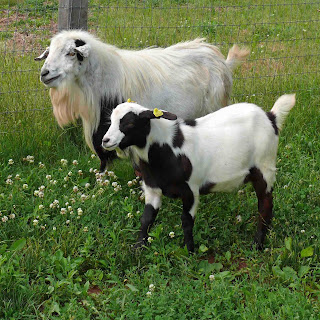 When I tell people we sell goats, the next question is usually 'what kind?'. When I tell them I sell Tennessee Fainting goats, I usually get a blank stare or a faint recollection of 'having heard' of that kind of goat before. Other common names used to describe this unique American breed include nervous goats, wooden-legged or stiff-legged, and scare-dy goats.
When I tell people we sell goats, the next question is usually 'what kind?'. When I tell them I sell Tennessee Fainting goats, I usually get a blank stare or a faint recollection of 'having heard' of that kind of goat before. Other common names used to describe this unique American breed include nervous goats, wooden-legged or stiff-legged, and scare-dy goats.The goats originated in 19th Century Tennessee when an itinerant farm hand, said to originate from Canada, showed up in Marshall County, Tennessee, with 3 does and a buck that were noted to 'faint' when startled. A year later this mysterious man moved on but only after selling his goats to a local country doctor, who was interested in examining this unusual neuromuscular disorder, Dr. Mayberry.


Tennessee Fainting goat is a bit of a misnomer - they actually have a congenital myotonic disorder, commonly referred to as Myotonia congenita, which in medical latin, is pretty non-specific. These goats don't actually faint, they stiffen and often fall over, hence the association to 'fainting'.


I usually refer to them as myotonic goats, as I feel this most accurately describes their condition.
When in a stiffened or down position, these goats are completely awake and aware of what's going on around them.

The molecular exact nature of their neuromuscular disorder has been studied and is not well-understood. Myotonia congenita in goats appears similar in many ways to diseases in humans and other animals sometimes referred to as channelopathies, including Thomsen's Disease and Becker's Myotonia congenita. These human disorders are characterized by painless, persistant muscular contraction following voluntary muscle contraction, and muscle hypertrophy. Cardiac and smooth muscle is not affected. We have more information on the exact nature of these disorders because humans that have these disorders can describe what and how they feel. We do not have this luxury in our goats.





Landrace refers to a breed that developed in geographic isolation. Those formative years in the hot, humid summers and mild winters of Tennessee means that myotonics now have a relatively high resistance to parasites like the barber pole worm as compared to other breeds like the Boer.


Myotonic goats also make excellent pets. They do not climb fences and have a sweet, friendly disposition.





Yeah, but can you milk them?
ReplyDeleteAs a matter of fact...yes you can!
ReplyDeleteGreat photo montage of the flock.
ReplyDeleteHow many do you have now?
I expect we'll have about 40 goats and 125 sheep through this coming winter!
ReplyDeleteHi, I work for Penguin Books and we need a picture of a myotonic goat to reproduce in one of our books, in b/w, one quarter page - it's to illustrate neurological disorders. Could I please request permission to use one of your photos on this page?
ReplyDeleteMy email is patrick.loughran@uk.penguingroup.com
I'd be grateful if you could let me know.
Best,
Patrick
I have wanted a goat and this is the kind of goat I want.
ReplyDelete